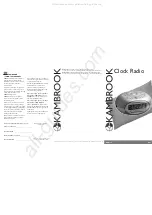
2
RADIO CONTROL FEATURE
The National Institute of Standards and Technology (NIST) is located in Fort Collins, Colorado. The NIST continuously
broadcasts the time signal (WWVB, 60KHz) which can be received anywhere in the continental United States where long
wave (AM) radio reception is possible. The signal can reach approximately 2,000 miles through the internal antenna in the
SkyScan Atomic Clock. However, due to the nature of the Earth’s atmosphere, reception is very limited during the daylight
hours. The clock will search for a signal every night when reception is best.
POSSIBLE RECEPTION-INTERFERING SOURCES
All radio-controlled clocks may be subject to certain interferences. Interferences can be caused for example by a
thunderstorm or metallic elements in buildings (such as windows with a metal frame). Domestic appliances and PCs, can
interfere with the reception. If you are in a location where it is difficult to receive the signal, the clock can be set manually
and then it will automatically update to the correct atomic time when it receives the signal. Normally, signal reception is
best at night. If the signal is not received in the first four minutes, it is recommended you set the time manually and wait for
the clock to catch the signal at night. Once the time is set (either automatically or manually), the clock will seek out the
radio signal daily to keep its accuracy.
RADIO CONTROL TIME UPDATE
The clock receives the WWVB time signal via its built-in antenna and adjusts automatically. Once the correct time is
set, the clock will run with an internal quartz-controlled mechanism.
The reception system of the clock daily for the WWVB signal at 2:00 a.m. If no signal is received within 4 minutes,
the system will automatically search again at 3:00 a.m., 4:00 a.m. and 4:00 p.m.
The internal quartz-mechanism is very accurate; therefore it does not matter if the clock is occasionally unable to
receive the time signals.























